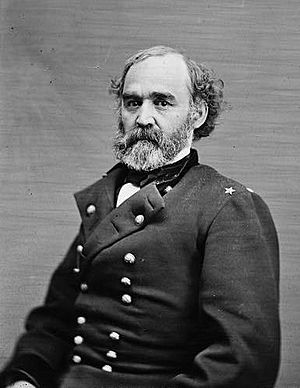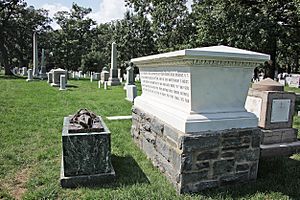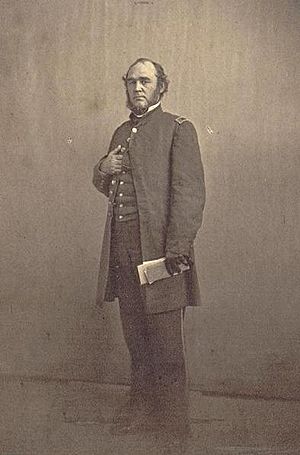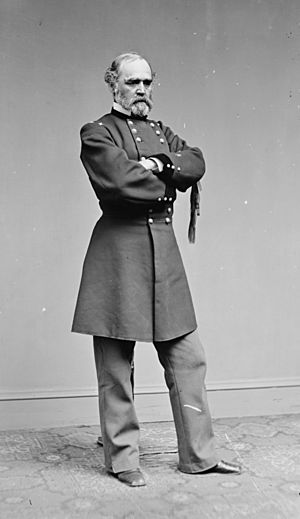Montgomery C. Meigs facts for kids
Quick facts for kids
Montgomery Cunningham Meigs
|
|
|---|---|

Montgomery C. Meigs
|
|
| Born | May 3, 1816 Augusta, Georgia, US |
| Died | January 2, 1892 (aged 75) Washington, D.C., US |
| Buried | |
| Allegiance | United States Union |
| Service/ |
United States Army Union Army |
| Years of service | 1836–1882 |
| Rank | |
| Commands held | Quartermaster General |
| Battles/wars | American Civil War |
| Relations | John Rodgers Meigs (son) "Monty" Meigs (son) |
| Other work | Smithsonian Institution regent National Academy of Sciences, member, builder of Arlington National Cemetery |
Montgomery Cunningham Meigs ( May 3, 1816 – January 2, 1892) was a career United States Army officer and civil engineer, who served as Quartermaster General of the U.S. Army during and after the American Civil War. Meigs strongly opposed secession and supported the Union; his record as Quartermaster General was regarded as outstanding, both in effectiveness and in ethical probity, and Secretary of State William H. Seward viewed it as a key factor in the Union victory.
Meigs was one of the principal architects of Arlington National Cemetery; the choice of its location, on Robert E. Lee's family estate, Arlington House, was partly a gesture to humiliate Lee for siding with the Confederacy.
Contents
Early life and engineering projects
Meigs was born in Augusta, Georgia, in May 1816. He was the son of Dr. Charles Delucena Meigs and Mary Montgomery Meigs. His father was a nationally known obstetrician and professor of obstetrics at Jefferson Medical College. His grandfather, Josiah Meigs, graduated from Yale University (where he was a classmate of future dictionary creator Noah Webster and American Revolutionary War general and politician Oliver Wolcott), and later was president of the University of Georgia. Montgomery Meigs' mother, Mary, was the granddaughter of a Scottish family from Brigend (with somewhat distant claims to a baronetcy) which emigrated to America in 1701.
Meigs' father apprenticed as a physician in Philadelphia until 1812, at which time he moved to Athens, Georgia. He enrolled at the University of Pennsylvania in 1815, the same year he began to practice medicine in Georgia. Charles Meigs received his MD from the University of Pennsylvania in 1817, and that summer he moved his family—which now included one-year-old Montgomery—to Philadelphia and established a practice there. The Meigs family was wealthy and well-connected, and Charles Meigs was a strong supporter of the Democratic Party. Meigs had extremely good memory, and his father instilled in him a sense of duty and a desire to pursue honorable causes. Young Montgomery received schooling at the Franklin Institute (then a preparatory school for the University of Pennsylvania). Meigs learned French, German, and Latin, and studied art, literature, and poetry. He enrolled at the University of Pennsylvania when he was only 15 years old. A hard worker, he was one of the top students at the university.
The Meigs family had extensive ties to the military and to West Point, the United States Military Academy. Montgomery Meigs, caught up in the nationalistic fervor of the time, wished to serve in the army. West Point was the only well established engineering school in the United States at the time. Through family connections, Meigs won an appointment to West Point, entering in 1832. He excelled in his studies at West Point, although he himself said he spent too much time at athletics and outdoor activities. He was among the top three students in French and mathematics, and did well in history. He graduated fifth out of a class of 49 in 1836, and he had more good conduct merits than two-thirds of his classmates.
He received a commission as a second lieutenant in the 1st U.S. Artillery, but most of his army service was with the Corps of Engineers, in which he worked on important engineering projects.
In his early assignments, Meigs helped build Fort Mifflin and Fort Delaware, both on the Delaware River, and Fort Wayne on the Detroit River. He also served under the command of then-Lt. Robert E. Lee to make navigational improvements on the Mississippi River. Beginning in 1844, Meigs also was involved with the construction of Fort Montgomery on Lake Champlain in upstate New York.
His favorite prewar engineering project was the Washington Aqueduct, which he supervised from 1852 to 1860. It involved the construction of the monumental Union Arch Bridge across Cabin John Creek, designed by Alfred Rives, which for 50 years remained the longest single-span masonry arch in the world. From 1853 to 1859, he also supervised the building of the wings and dome of the United States Capitol and, from 1855 to 1859, the extension of the General Post Office Building.
In the fall of 1860, as a result of a disagreement over procurement contracts, Meigs incurred the ill will of the Secretary of War, John B. Floyd, and was banished to Tortugas in the Gulf of Mexico to construct fortifications there and at Key West, including Fort Jefferson, Florida. Upon the resignation of Floyd a few months later, Meigs was recalled to his work on the aqueduct at Washington.
Civil War
Just before the outbreak of the Civil War, Meigs and Lt. Col. Erasmus D. Keyes were quietly charged by President Abraham Lincoln and Secretary of State William H. Seward with drawing up a plan for the relief of Fort Pickens, Florida, by means of a secret expedition. In April 1861, together with Lieutenant David D. Porter of the Navy, they carried out the expedition, embarking under orders from the President without the knowledge of either the Secretary of the Navy or the Secretary of War.
On May 14, 1861, Meigs was appointed colonel, 11th U.S. Infantry, and on the following day, promoted to brigadier general and Quartermaster General of the Army. The previous Quartermaster General, Joseph Johnston, had resigned and become a general in the Confederate Army. Meigs established a reputation for being efficient, hard-driving, and scrupulously honest. He molded a large and somewhat diffuse department into a great tool of war. He was one of the first to fully appreciate the importance of logistical preparations in military planning, and under his leadership, supplies moved forward and troops were transported over long distances with ever-greater efficiency.
Of his work in the quartermaster's office, James G. Blaine remarked:
Montgomery C. Meigs, one of the ablest graduates of the Military Academy, was kept from the command of troops by the inestimably important services he performed as Quartermaster General. Perhaps in the military history of the world there never was so large an amount of money disbursed upon the order of a single man ... The aggregate sum could not have been less during the war than fifteen hundred million dollars, accurately vouched and accounted for to the last cent.
Secretary of State William H. Seward's estimate was "that without the services of this eminent soldier the national cause must have been lost or deeply imperiled."
Meigs' services during the Civil War included command of Lieutenant General Ulysses S. Grant's base of supplies at Fredericksburg and Belle Plain, Virginia (1864); command of a division of War Department employees in the defense of Washington at the time of Jubal A. Early's raid (July 11 to 14, 1864); personally supervising the refitting and supplying of Major General William T. Sherman's army at Savannah (January 5 to 29, 1865), Goldsboro, and Raleigh, North Carolina and reopening Sherman's lines of supply (March to April 1865). He was brevetted to major general on July 5, 1864.
A staunch Unionist, Meigs detested the Confederacy. His feelings led directly to the establishment of Arlington National Cemetery. On July 16, 1862, Congress passed legislation authorizing the U.S. federal government to purchase land for national cemeteries for military dead, and put the U.S. Army Quartermaster General in charge of this program. The Soldiers' Home in Washington, D.C., and the Alexandria Cemetery were the primary burying grounds for war dead in the D.C. area, but by late 1863 both cemeteries were full. In May 1864, Union forces suffered large numbers of dead in the Battle of the Wilderness. Meigs ordered that an examination of eligible sites be made for the establishment for a large new national military cemetery. Within weeks, his staff reported that Arlington Estate was the most suitable property in the area. The property was high and free from floods (which might unearth graves), it had a view of the District of Columbia, and it was aesthetically pleasing. It was also the home of Robert E. Lee, future General-in-Chief of the Confederacy, and denying Lee use of his home after the war was a valuable political consideration. Although the first military burial at Arlington had been made on May 13, Meigs did not authorize establishment of burials until June 15, 1864. Meigs ordered that the estate be surveyed and that 200 acres (81 ha) be set aside for use as a cemetery.
The logistics system
While the Confederacy never had enough supplies and it kept getting worse, the Union forces typically had enough food, supplies, ammunition and weapons. The Union supply system, even as it penetrated deeper into the South, maintained its efficiency. Historians credit the achievements to Meigs. Union quartermasters were responsible for most of the $3 billion spent for the war. They operated out of sixteen major depots, which formed the basis of the system of procurement and supply throughout the war. As the war expanded, operation of these depots became much more complex, with an overlapping and interweaving relationship between the army and government operated factories, private factories, and numerous middlemen. The purchase of goods and services through contracts supervised by the quartermasters accounted for most of federal military expenditures, apart from the wages of the soldiers. The quartermasters supervised their own soldiers, and cooperated closely with state officials, manufacturers and wholesalers trying to sell directly to the army; and representatives of civilian workers looking for higher pay at government factories. The complex system was closely monitored by congressmen anxious to ensure that their districts won their share of contracts. The system grew in efficiency to the point Union troops on long marches would simply throw away excess knapsacks, bedrolls, overcoats, and other pieces of clothing and equipment that they felt were weighing them down, fully confident that they would be resupplied at some point in the near future.
Pension Building (1882 to 1887)
Following the end of the Civil War, the US Congress passed legislation that greatly extended the scope of pension coverage for both veterans and their survivors and dependents, notably their widows and orphans. This greatly increased the number of staff needed to administer the new benefits system. More than 1,500 clerks were required, and a new building was needed to house them. Meigs was chosen to design and construct the new building, now the National Building Museum. He broke away from the established Greco-Roman models that had been the basis of government buildings in Washington, D.C., until then, and was to continue following the completion of the Pension Building. Meigs based his design on Italian Renaissance precedents, notably Rome's Palazzo Farnese and Palazzo della Cancelleria.

Included in his design was a 1,200-foot (370 m) long sculptured frieze executed by Caspar Buberl. Since creating a work of sculpture of that size was well out of Meigs's budget, he had Buberl create 28 different scenes (totaling 69 feet (21 m) in length), which were then mixed and slightly modified to create the continuous 1,200-foot (370 m) long parade that includes over 1,300 figures. Because of the way the 28 sections are modified and mixed up, only somewhat careful examination reveals the frieze to be the same figures repeated over and over. The sculpture includes infantry, navy, artillery, cavalry, and medical components, as well as a good deal of the supply and quartermaster functions. Meigs's correspondence with Buberl reveals that Meigs insisted that one teamster, "must be a negro, a plantation slave, freed by war," be included in the quartermaster panel. This figure was ultimately to assume a position in the center, over the west entrance to the building.
When Philip Sheridan was asked to comment on the building, his reply echoed the sentiment of many of the Washington establishment of the day, that the only thing that he could find wrong with the building was that it was fireproof. (A similar quote is also attributed to William T. Sherman, so the story might well be apocryphal.) The completed building, sometimes referred to as "Meigs's Old Red Barn", was created by using more than 15,000,000 bricks, which, according to the wits of the day, were all counted by the parsimonious Meigs.
Death
Meigs contracted a cold on December 27, 1891. Within a few days, it turned into pneumonia. Meigs died at home at 5:00 pm on January 2, 1892. His body was interred with high military honors in Arlington National Cemetery. General orders issued at the time of his death declared, "the Army has rarely possessed an officer ... who was entrusted by the government with a great variety of weighty responsibilities, or who proved himself more worthy of confidence."
Family
In 1841, Meigs married Louisa Rodgers (1816–1879), the daughter of Commodore John Rodgers. Their children included:
- John Rodgers Meigs (1842–1864), a West Point graduate and Army officer who was killed in action during the Civil War
- Mary Montgomery Meigs (1843–1930), the wife of Army officer Joseph Hancock Taylor, who was the son of Union Army Brigadier General Joseph Pannell Taylor, and nephew of President Zachary Taylor
- Charles Delucena Meigs (1845–1853), who was named for Meigs' father
- Montgomery Meigs (1847–1931), a civil engineer who enjoyed a long career in railroad, bridge, canal, power plant, and road construction
- Vincent Trowbridge Meigs (1851–1853)
- Louisa Rodgers Meigs (1854–1922), the wife of British journalist Archibald Forbes
Honors
- General Meigs was inducted into the Quartermaster Hall of Fame in its charter year of 1986.
- In 2012, the Georgia Historical Society erected a historical marker at the birthplace of Gen. Montgomery C. Meigs in Augusta, Georgia.
- Camp Megis, in Readville, Massachusetts was named after him.
Ships
- General Meigs, a Quartermaster Corps passenger and freight steamer built in 1892 and serving in the early 20th century.
- USAT Meigs, an Army transport ship sunk at Darwin, Northern Territory.
- USS General M. C. Meigs (AP-116), a troop transport launched in 1944, serving in WWII and Korea.
Images for kids






